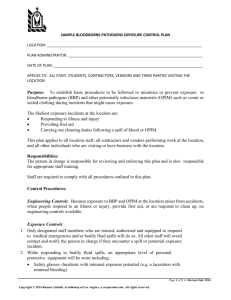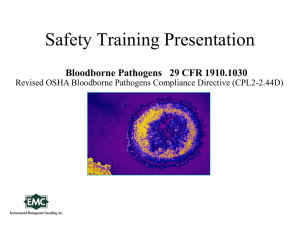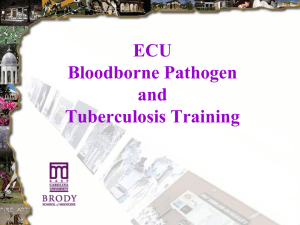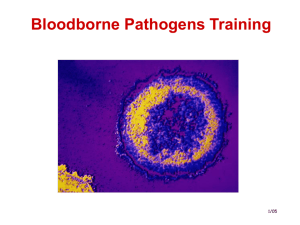THE UNIVERSITY OF MEMPHIS EXPOSURE CONTROL PLAN DATE:
advertisement
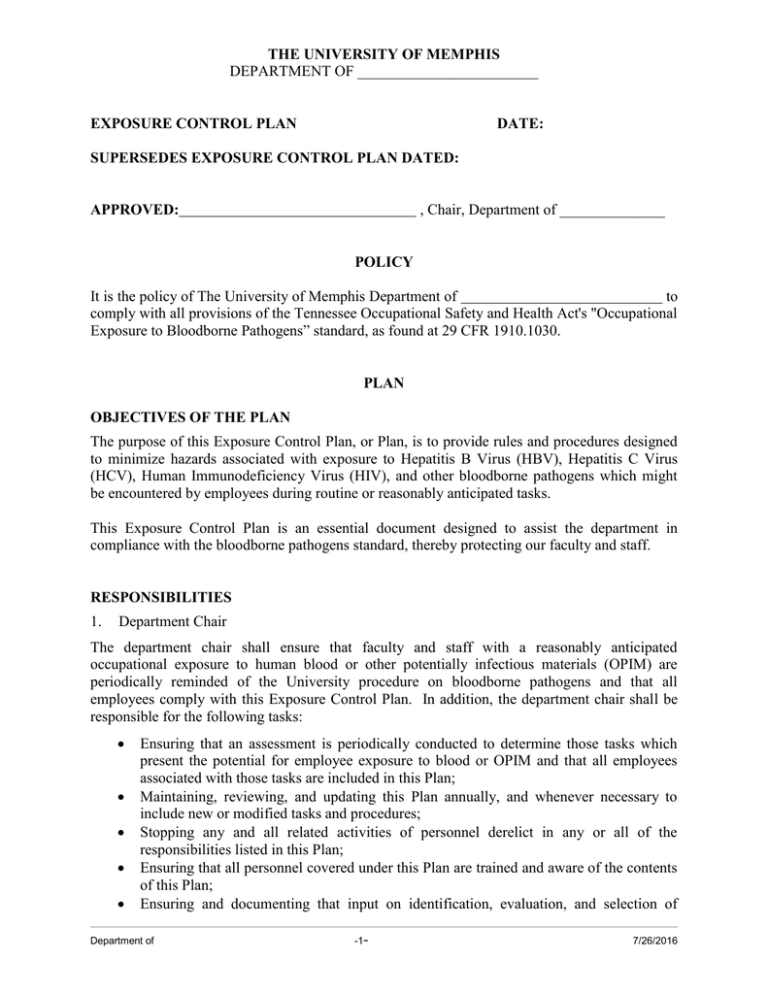
THE UNIVERSITY OF MEMPHIS DEPARTMENT OF ________________________ EXPOSURE CONTROL PLAN DATE: SUPERSEDES EXPOSURE CONTROL PLAN DATED: APPROVED: , Chair, Department of ______________ POLICY It is the policy of The University of Memphis Department of to comply with all provisions of the Tennessee Occupational Safety and Health Act's "Occupational Exposure to Bloodborne Pathogens” standard, as found at 29 CFR 1910.1030. PLAN OBJECTIVES OF THE PLAN The purpose of this Exposure Control Plan, or Plan, is to provide rules and procedures designed to minimize hazards associated with exposure to Hepatitis B Virus (HBV), Hepatitis C Virus (HCV), Human Immunodeficiency Virus (HIV), and other bloodborne pathogens which might be encountered by employees during routine or reasonably anticipated tasks. This Exposure Control Plan is an essential document designed to assist the department in compliance with the bloodborne pathogens standard, thereby protecting our faculty and staff. RESPONSIBILITIES 1. Department Chair The department chair shall ensure that faculty and staff with a reasonably anticipated occupational exposure to human blood or other potentially infectious materials (OPIM) are periodically reminded of the University procedure on bloodborne pathogens and that all employees comply with this Exposure Control Plan. In addition, the department chair shall be responsible for the following tasks: Ensuring that an assessment is periodically conducted to determine those tasks which present the potential for employee exposure to blood or OPIM and that all employees associated with those tasks are included in this Plan; Maintaining, reviewing, and updating this Plan annually, and whenever necessary to include new or modified tasks and procedures; Stopping any and all related activities of personnel derelict in any or all of the responsibilities listed in this Plan; Ensuring that all personnel covered under this Plan are trained and aware of the contents of this Plan; Ensuring and documenting that input on identification, evaluation, and selection of Department of -1- 7/26/2016 2. effective engineering and work practice controls is solicited from non-management employees who are potentially exposed to injuries from contaminated sharps, and Ensuring that universal precautions, engineering controls, and work practice controls are implemented and that they become a part of standard operating procedures. Supervisors Supervisors of areas where there is potential for exposure to human blood or OPIM shall be responsible for the following tasks: 3. Determining those tasks which present the potential for employee exposure to blood or OPIM and including all employees associated with these tasks in this Plan; Implementing universal precautions within the area; Providing personal protective equipment (PPE) and clothing for included personnel, that appropriate PPE training is received by covered personnel, and that PPE is used and properly maintained; and Providing the level of supervision necessary to implement this Plan within the area. Faculty and Staff Individual faculty and staff shall comply with the procedures and work practices included in this Plan. 4. Environmental Health and Safety Office The Environmental Health and Safety Office (EH&S) shall provide assistance in the implementation of this Plan. EXPOSURE DETERMINATION Work processes shall be periodically evaluated using Attachment 4 or an accepted alternative to determine which tasks present the potential for employee exposure to human blood or OPIM. All job classifications in the Department of _____________________________ in which employees have reasonably anticipated occupational exposure during routine operations or reasonably anticipated tasks are listed in Attachment 1. Attachment 1 shall be maintained and updated at least annually. CONTROL METHODS AND IMPLEMENTATION The following control measures are utilized to reduce employee exposure to bloodborne pathogens. 1. Universal Precautions Personnel included in this Plan shall treat all human blood and OPIM as if known to be infectious. 2. Engineering Controls Engineering controls designed to eliminate hazards at their source shall be utilized; these include, but are not limited to, puncture resistant sharps containers, mechanical pipetting, needleless systems, and engineered sharps. Department of -2- 7/26/2016 Engineered sharps injury prevention devices shall be identified, evaluated, and selected; approved devices are listed in Attachment 3. If it is determined that such technology is medically contraindicated or is not more effective than alternate measures used by the department to prevent exposure incidents, a written assessment will be developed, signed by the department chair, and incorporated into this Plan as Attachment 7. Input in identification, evaluation, and selection of engineered sharps injury prevention devices shall be solicited from non-management employees who are potentially exposed to injuries from contaminated sharps. 3. Work Practices Work practices implemented within the Department of include, but are not limited to, procedures for processing and handling human blood and OPIM, waste disposal, and personal hygiene. Employees shall 4. Dispose of all needles or other sharps in designated sharps containers which are clearly marked; Never bend, shear, recap, or remove contaminated needles or other contaminated sharps; Place contaminated, reusable sharps in appropriate containers immediately, or as soon as possible after use; Perform all procedures involving blood or OPIM in such a manner as to minimize splashing or spraying; Never eat, drink, smoke, apply cosmetics or lip balm, or handle contact lenses in work areas where blood or OPIM are present; Never store food or drink in refrigerators, freezers, shelves, cabinets, or on counter tops or bench tops where blood or OPIM are present; Place specimens of blood or OPIM in containers that prevent leakage during collection, handling, processing, storage, transport, or shipping; Label containers of blood or OPIM with the biohazard symbol or color code in red; Close containers of blood or OPIM prior to being stored, transported, or shipped; Store containers of blood or OPIM in a secure area which is inaccessible to unauthorized personnel; Apply a University biohazard tag to all waste containers when full. Personal Protective Equipment (PPE) Work place risk assessments shall be completed to determine the required PPE for employees covered by this Plan. Employees shall be trained in proper use of PPE in accordance with TOSHA standard 29 CFR 1910.134. PPE shall be made available in appropriate sizes to affected employees at no cost to the employees and shall be readily accessible. Used PPE shall be treated as if contaminated with potentially infectious material, and shall not be left in the work area. The University will clean, launder, or dispose of used equipment as appropriate. Laundry shall be cleaned as indicated in Attachment 2. No employee shall be required to take home PPE, including lab coats, for laundry or cleaning. The location of PPE and the name of the person responsible for issuing such equipment are also listed in Attachment 2. Where PPE is required, employees shall implement the following work practices: Wear appropriate gloves when hand contact with blood or OPIM is reasonably anticipated. Department of -3- 7/26/2016 Replace gloves frequently. Dispose of disposable gloves properly; never decontaminate for reuse. Inspect decontaminated, reusable gloves frequently; dispose of gloves showing signs of cracking, peeling, tearing, puncturing, or deterioration. Wear face and eye protection where splashes, sprays, spatters, or droplets of blood or OPIM pose a hazard to the eyes, nose, or mouth. Wear appropriate protective clothing such as, but not limited to, lab coats and clinic jackets in occupational exposure situations. The type and characteristics of protective clothing will depend upon the task and degree of exposure anticipated to prevent blood or OPIM from reaching street clothes, work clothes, or skin. Remove all personal protective equipment and protective clothing immediately upon leaving the work area, and place in an appropriately designated area or container for storage, washing, decontamination, or disposal. Wash hands and other exposed skin with soap and water as soon as feasible after removal of gloves or other personal PPE, or following skin contact with blood or OPIM. PPE shall be considered appropriate only when it does not permit blood or OPIM to pass through to or reach the employee's clothes, skin, eyes, mouth, or other mucous membranes under normal conditions of use for the duration of time during which the equipment is used. 5. Housekeeping All work areas shall be maintained in a clean and sanitary condition. An appropriate cleaning schedule shall be developed and implemented for rooms where blood or OPIM are present; this schedule is found in Attachment 2. Cleaning shall be as frequent as necessary depending on the area of the institution, type of surface to be cleaned, and type of soil present. The following practices shall be implemented: Equipment and work surfaces shall be cleaned and decontaminated after contact with blood or OPIM and at the end of the work session/day. Decontamination of contaminated work surfaces shall be accomplished with an appropriate disinfectant. Recommended solutions are 1:10 mixture of chlorine bleach to water or Lysol® of appropriate strength. Protective coverings used on equipment and environmental surfaces shall be replaced at the end of the work session/day and when contaminated. Bins, pails, cans, sharps containers, and similar receptacles shall be inspected and decontaminated on a regular schedule. This schedule is listed in Attachment 2. Contaminated broken glassware shall not be picked up with the hands. Mechanical means such as brush and dustpan, tongs, or forceps shall be used. Reusable sharps that are contaminated with blood or OPIM shall not be stored or processed in a manner that requires employees to reach into storage containers. When performing housekeeping functions, Department of employees shall wear appropriate personal protective equipment, including general-purpose utility gloves during all cleaning of blood or OPIM and during decontamination procedures. Initial clean-up of blood or OPIM shall be followed with the use of an approved hospital disinfectant chemical germicide that is tuberculocidal [undiluted Lysol® or a solution of 5.25% sodium hypochlorite (household bleach) diluted one (1) part bleach to nine (9) parts water]. Bleach solution should be made fresh each day. Department of -4- 7/26/2016 Equipment contaminated with blood or other potentially infectious materials shall be checked routinely and decontaminated prior to servicing or shipping. HBV VACCINATION Within ten (10) days of initial work assignment involving potential exposure to human blood or OPIM, an affected employee shall be offered, at no cost to the employee, the HBV vaccination unless the employee has (1) previously received the complete HBV vaccination series, (2) antibody testing has shown the employee to be immune, or (3) the vaccine is contraindicated for medical reasons. Vaccinations shall be given according to recommendations for standard medical practice. The employee may accept or decline. If the employee declines, a declination statement must be signed and forwarded to the Benefits Section of Human Resources as noted in Attachment 2. If the employee later decides to accept, the vaccine will then be given at no cost. A Hepatitis B Vaccine Waiver is found in Attachment 5. INFECTIOUS WASTE DISPOSAL For a waste to be infectious, it must contain pathogens with sufficient virulence and quantity so that exposure to the waste by a susceptible host could result in an infectious disease. Certain factors are necessary for induction of disease; these include presence of a pathogen of sufficient virulence, dosage, portal of entry, and resistance of host. The following shall be considered as infectious waste. 1. Human Blood, and Blood Products These wastes include human blood in liquid state, products of blood, items saturated and/or dripping with human blood, items caked with dried human blood (including serum, plasma, and other blood components), containers that were used or intended for use in patient care, testing, and laboratory analysis, and used IV bags. 2. Other Potentially Infectious Materials These wastes include semen, vaginal secretions, cerebrospinal fluid, synovial fluid, pleural fluid, pericardial fluid, peritoneal fluid, amniotic fluid, saliva in dental procedures, any body fluid that is visibly contaminated with blood, and any body fluids in situations where it is difficult or impossible to differentiate between body fluids. 3. Contaminated Sharps Contaminated sharps are any contaminated object that can penetrate the skin, including, but not limited to: hypodermic needles, Pasteur pipettes, scalpel blades, microtome blades, needles with tubing attached, capillary tubes, broken glass, and related items such as used slides and cover slips. All sharps are typically disposed of through the University medical waste contractor. The following procedures shall be followed in disposing of infectious waste: Disposal of all infectious waste shall be in accordance with applicable Federal, State, and local regulations. EH&S can provide assistance with this. Department of -5- 7/26/2016 All infectious waste shall be placed in closable, leak-proof containers or bags that are color-coded, labeled, and tagged. Disposable syringes, needles, scalpel blades and other sharp items shall be placed in puncture-resistant containers for disposal. Puncture-resistant sharps containers shall be easily accessible to workers and located in areas where sharps are commonly used. When full, these containers shall be securely closed and disposed through the University medical waste contractor. Double bagging prior to handling, storing, and/or transporting infectious waste is necessary if the outside of a bag is contaminated with blood and/or OPIM. WARNING LABELS, SIGNS, AND TAGS Warning labels will be affixed to containers of regulated waste, refrigerators containing blood, and any other containers used to store, transport, or ship blood or OPIM. Contaminated equipment shall have appropriate warning labels attached. Warning labels shall comply with requirements of 29 CFR 1910.145. The University biohazard tag may be obtained from EH&S and will be filled out by the department representative, stating the specific hazardous condition or the instructions to be communicated to employees. The words and message must be understandable to all employees who may be exposed to the identified hazard. Labels/tags may be an integral part of the container or affixed as close as safely possible to their respective hazards by string, wire, or adhesive to prevent loss or unintentional removal. Red bags or red containers may be substituted for labels on containers of infectious waste. All employees shall be informed of the meaning of various labels, tags, and color-coding system. COMMUNICATION OF HAZARDS TO EMPLOYEES AND TRAINING All employees who are determined to have occupational exposure to blood or OPIM shall receive training conducted by the person or department noted in Attachment 2. This training shall be provided during normal working hours upon initial assignment and annually thereafter. All employees with reasonably anticipated exposure to blood must participate in a training and education program. The material used in the training and education program will be appropriate in content and vocabulary to the educational level, literacy, and language background of the employees receiving the training. The training program shall contain the following elements: A general explanation of the epidemiology, symptoms, and modes of transmission of HIV, HBV, and HCV An explanation of the department's Exposure Control Program A copy and explanation of the bloodborne pathogen standard (29 CFR 1910.1030) An explanation of the use and limitations of methods of control that may prevent or reduce exposure, including universal precautions, engineering controls, work practices, and personal protective equipment An explanation of the types, uses, location, removal, handling, decontamination, and disposal of PPE An explanation of the basis for selection of personal protective equipment Department of -6- 7/26/2016 Information on the hepatitis B vaccine, including information on its efficacy, safety, method of administration, the benefits of being vaccinated, and that the vaccine will be offered free of charge Information on the appropriate actions to take and persons to contact in an emergency involving blood or OPIM An explanation of the procedure to follow if an exposure incident occurs, method of reporting the incident, and the medical follow-up that will be made available. Information on the post-exposure evaluation and follow-up that the employer is required to provide for the employee following an exposure incident An explanation of the signs, labels, tags, and/or color coding used to denote biohazards An opportunity for interactive questions and answers with the person conducting the training session. Training materials for this facility are available from the person or department noted in Attachment 2. RECORDKEEPING 1. The Department of Human Resources shall track each employee's reported exposure incident to blood or OPIM. 2. All needle stick injuries shall be reported to the Environmental Health and Safety Office which will include them on the University's OSHA 300 occupational injury and illness log if medical treatment such as gamma globulin, hepatitis B immune globulin, or hepatitis B vaccine is prescribed and administered by a licensed medical professional. 3. HBV and HIV will be recorded by the Environmental Health and Safety Office on the OSHA 300 log if the illness can be traced back to an injury or other exposure incident in conjunction with the definitions of a work related incident. 4. A sharps injury log shall be maintained by Environmental Health and Safety to record percutaneous injuries from contaminated sharps. Information in this log shall be recorded and maintained in a manner that will protect the confidentiality of the injured employee. This log shall be maintained for five years from the end of the year to which the log relates. The sharps injury log shall contain at least the following information: 5. The type and brand of device involved in the injury, The department or work area where the exposure incident occurred, and An explanation of how the incident occurred. Training Records Training records are completed for each employee upon completion of training. The person or department noted in Attachment 2 shall keep these documents for at least three years. Training records should include: Dates of the training sessions, Contents or a summary of the training sessions, Department of -7- 7/26/2016 Names and qualifications of persons conducting the training, and Names and job titles of all persons attending the training sessions Employee training records shall be provided upon request to the employee or the employee's authorized representative within 15 working days. Such requests should be addressed to the person or department noted in Attachment 2 as responsible for maintaining training records. 6. Medical Records Medical records are maintained for each employee with occupational exposure in accordance with 29 CFR 1910.20, "Access to Employee Exposure and Medical Records." The Human Resources Department is responsible for maintenance of the required medical records; these confidential records are kept for at least the duration of employment plus 30 years. Employee medical records are provided upon request of the employee, or to anyone having written consent of the employee, within 15 working days. Such requests should be sent to the Assistant Vice President for Human Resources. POST-EXPOSURE EVALUATION AND FOLLOW-UP In the event that an exposure incident occurs, the following actions should be taken: Clean the wound and surrounding area thoroughly. A splash to the eyes, mouth, or nose should be attacked with copious amounts of water. Notify the employee's supervisor. Seek medical attention from one of the authorized providers from the state workers' compensation network. A copy of the list may be attached to this ECP. Immediate first aid may be obtained at Student Health Services during normal working hours. Complete the “Unusual Occurrence/Incident Report” form (Attachment 6). Complete the “First Report of Injury or Illness" form. The confidential medical evaluation and follow-up conducted by the approved workers' compensation provider will include the following: Document the routes of exposure and how the exposure occurred. Identify and document the source individual (unless it can be established that identification is infeasible). Obtain consent and make arrangements to have the source individual tested as soon as possible to determine HIV, HBV, and HCV infectivity; document that the source individual's test results were conveyed to the health care provider. If consent cannot be obtained, document that consent was not granted. If the source individual is already known to be HIV, HBV and/or HCV positive, new testing need not be performed. Assure that the exposed employee is provided with the source individual's test results and with information about applicable disclosure laws and regulations concerning the identity and infectious status of the source individual. After obtaining consent, collect exposed employee's blood as soon as feasible after exposure incident, and test blood for HIV, HBV, and HCV serological status. If the employee does not give consent for serological testing during collection of blood for baseline testing, preserve the baseline blood sample for at least 90 days; if the exposed employee elects to have the baseline sample tested during this waiting period, perform testing as soon as feasible. Department of -8- 7/26/2016 Offer the employee post exposure prophylaxis in accordance with current U.S. Public Health Service recommendations. The University will offer the exposed employee repeat HIV testing at 6 weeks post exposure and on a periodic basis thereafter (12 weeks and 6 months after exposure). Follow-up of the exposed worker shall include counseling, medical evaluation of any acute febrile illness that occurs within twelve weeks post-exposure, and use of safety and effective post-exposure measures according to recommendations of standard medical practice. ADMINISTRATION OF POST-EXPOSURE EVALUATION AND FOLLOW-UP Attachment 2 includes the name of the person or department who will ensure that health care professionals responsible for employee hepatitis B vaccination is given a copy of OSHA's bloodborne pathogens standard, and that the health care professional responsible for postexposure evaluation and follow-up is provided with the following information: Description of the employee's job duties relevant to the exposure incident Route(s) of exposure Circumstances of exposure Results of the source individual's blood test, if available Relevant employee medical records, including vaccination status Attachment 2 contains the name of person or department designated to provide the employee with a copy of the evaluating health care professional's written opinion within 15 days after completion of the evaluation. PROCEDURES FOR EVALUATING THE CIRCUMSTANCES SURROUNDING AN EXPOSURE INCIDENT Following an exposure incident, the Environmental Health and Safety Office and the chair of the affected department will conduct an investigation to evaluate the circumstances surrounding the exposure incident. The report of findings and resolutions of the exposure incident will be distributed to, but not limited to, the following: The person(s) directly involved in the incident. Human Resources (to be placed in the individual’s medical file). Environmental Health and Safety Office The investigation will review the circumstances of all exposure incidents to determine: Engineering controls in use at the time Work practices followed A description of the device being used Protective equipment or clothing that was used at the time of the exposure incident Location of the incident Procedure being performed when the incident occurred Employee's training status If it is determined that revisions need to be made to this Plan, the department chair will ensure Department of -9- 7/26/2016 that appropriate changes are made. (Changes may include an evaluation of safer devices, adding employees to the exposure determination list, etc.) Department of -10- 7/26/2016 Attachment 1 EMPLOYEE EXPOSURE DETERMINATION LIST FOR DEPARTMENT The following Exposure Determination has been made in conjunction with Attachment 4 without regard to the use of personal protective equipment. ALL employees in the following job classifications may be at risk for occupational exposure as a result of the performance of their duties. Included is a list of tasks and procedures, or groups of closely related tasks and procedures, in which occupational exposure may occur for these individuals. JOB CLASSIFICATION TASK/PROCEDURE Attachment 1 Page 2 SOME employees in the following job classifications may be at risk for occupational exposure as a result of the performance of their duties. Included is a list of tasks and procedures, or groups of closely related tasks and procedures, in which occupational exposure may occur for these individuals. JOB CLASSIFICATION TASK/PROCEDURE An assessment has been performed to evaluate the bloodborne pathogen/OPIM associated with the listed tasks and procedures. This Exposure Determination will be reviewed and updated annually or as required to reflect addition of new employees or changes in responsibilities. _____________________________________________ Signature _____________________________________________ Date _____________________________________________ Print Name Attachment 3 The University of Memphis Department of __________________________________ ENGINEERED SHARPS INJURY PREVENTION DEVICES Device _____________________________________________ Signature _____________________________________________ Date _____________________________________________ Print Name Approved Use Attachment 5 HBV VACCINATION DECLARATION OF REFUSAL I understand that due to my occupational exposure to blood or other potentially infectious materials I may be at risk of acquiring hepatitis B virus (HBV) infection. I have been given the opportunity to be vaccinated with hepatitis B vaccine, at no charge to myself. However, I decline hepatitis B vaccination at this time. I understand that by declining this vaccine, I continue to be at risk of acquiring hepatitis B, a serious disease. If in the future I continue to have occupational exposure to blood or other potentially infectious materials and I want to be vaccinated with hepatitis B vaccine, I can receive the vaccination series at no charge to me. ___________________________________________ Signature ___________________________________________ Date ___________________________________________ Print Name ___________________________________________ Department (Please forward completed form to the Benefits Section of Human Resources) Attachment 4 The University of Memphis JOB ASSESSMENT: OCCUPATIONAL EXPOSURE TO HUMAN BLOOD OR OTHER POTENTIALLY INFECTIOUS MATERIALS (OPIM) Employee Name: Department: _________________________ Job Classification: Date: ______________________ As a result of performing duties in the above classifications, is there reasonably anticipated skin, eye, and mucus membrane contact with human blood or blood products? Yes No Is there reasonably anticipated skin, eye, mucus membrane contact with other potentially infectious materials (OPIM) during a normal work period: OPIM Semen Vaginal Secretions Cerebrospinal fluid Synovial fluid Pleural fluid Pericardial fluid Peritoneal fluid Amniotic fluid Saliva in dental procedures Any body fluid that is visibly contaminated with blood All body fluids in situations where it is difficult or impossible to differentiate between body fluids Any unfixed tissue or organ from a human (other than intact skin, from living or dead homosapien) HIV-containing cell, tissue cultures, organ cultures, and other solutions Blood, organs, or other tissues from experimental animals infected with HIV- or HBV Parenteral (piercing the mucus membrane or the skin barrier through needle stick, human bites, cuts, and abrasions) Other possible OPIM situations not annotated by the above examples: YES NO Attachment 4 Page 2 List all tasks and procedures, or groups of closely related tasks and procedures, in which occupational exposure occurs and that are performed by the employee in the above job classification. REMARKS: __________________________________________________ Signature __________________________________________________ Date __________________________________________________ Print Name Attachment 6 The University of Memphis UNUSUAL OCCURRENCE / INCIDENT REPORT EXPOSURE TO BLOOD OR OTHER POTENTIALLY INFECTIOUS MATERIALS Employee Name: _____________________________ Social Security Number: ______________________ Position: ____________________________________ Department: ________________________________ Date of Exposure: _____________________________ Time: ________________ (AM/PM) Source of Exposure (if pricked by sharps, include Device Used, Type, and Brand ) : HBV and HIV status of Source Individual: _______________________________________________________ How Exposure Occurred: Immediate Action Taken: Protective Equipment Being Used (check appropriate box): Yes No N/A Comments: ________________________________________________________________________________ Incident Reported To: ________________________________ Physician Referral Scheduled: Yes No I understand the potential risks related to the exposure incident which occurred and agree to receive an examination and/or treatment for the exposure, as recommended by my physician. This includes serological testing for Hepatitis B, HIV virus, and other pathogens, if so indicated. I understand the potential risks related to the exposure incident which occurred and DO NOT agree to have an examination or treatment for the exposure. Employee Signature: Date: ___________________________ Supervisor Signature: Date:____________________________ Please Note: Employee’s supervisor must also complete "Supplementary Record of Injury or Illness” as required by The University of Memphis Operating Procedure 2D:00:10A. Attachment 2 The University of Memphis Department of _______________________________ Responsible Personnel and Departments: Function Training of Personnel Person or Department Responsible Training Materials Training Records Maintained Receives and Maintains HBV Declination Forms Ensures Health Care Provider for Hepatitis B Vaccination Receives Copy of OSHA BBP Standard Ensures Employee Receives copy of Health Care Professional's Written Opinion within 15 Days after Completion Benefits Section of Human Resources (Person to be designated within your department) Benefits Section of Human Resources Telephone Number Attachment 2 Page 2 Housekeeping Schedule: Area Cleaning Frequency Procedure Disinfectant Personal Protective Equipment: Task/Procedure PPE Required Attachment 2 Page 3 Personal Protective Equipment: PPE Type PPE Type Uncontaminated PPE to be Available Here Available from Whom Contaminated PPE to be Deposited Here Attachment 2 Page 4 Laundry: Contaminated Laundry to be Handled as Noted Below (NOTE: Contaminated laundry must not be taken home by employees for laundering.) _____________________________________________ Signature _____________________________________________ Date _____________________________________________ Print Name 22
